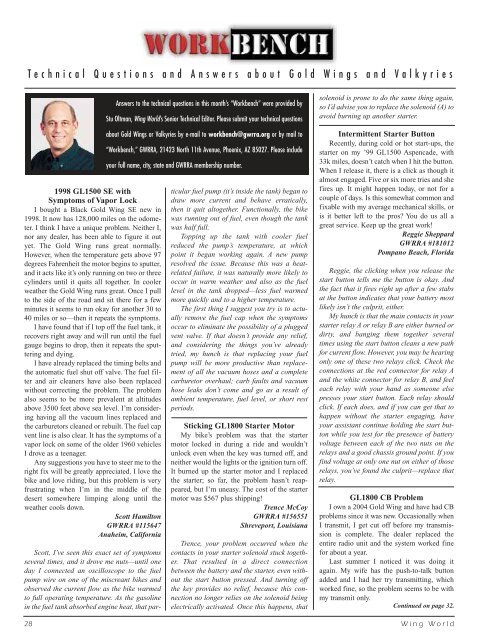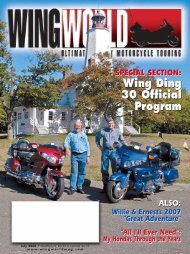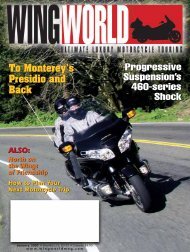to view pdf file of current issue - Wing World Magazine Archives
to view pdf file of current issue - Wing World Magazine Archives
to view pdf file of current issue - Wing World Magazine Archives
Create successful ePaper yourself
Turn your PDF publications into a flip-book with our unique Google optimized e-Paper software.
Technical Questions and Answers about Gold <strong>Wing</strong>s and Valkyries<br />
1998 GL1500 SE with<br />
Symp<strong>to</strong>ms <strong>of</strong> Vapor Lock<br />
I bought a Black Gold <strong>Wing</strong> SE new in<br />
1998. It now has 128,000 miles on the odometer.<br />
I think I have a unique problem. Neither I,<br />
nor any dealer, has been able <strong>to</strong> figure it out<br />
yet. The Gold <strong>Wing</strong> runs great normally.<br />
However, when the temperature gets above 97<br />
degrees Fahrenheit the mo<strong>to</strong>r begins <strong>to</strong> sputter,<br />
and it acts like it’s only running on two or three<br />
cylinders until it quits all <strong>to</strong>gether. In cooler<br />
weather the Gold <strong>Wing</strong> runs great. Once I pull<br />
<strong>to</strong> the side <strong>of</strong> the road and sit there for a few<br />
minutes it seems <strong>to</strong> run okay for another 30 <strong>to</strong><br />
40 miles or so—then it repeats the symp<strong>to</strong>ms.<br />
I have found that if I <strong>to</strong>p <strong>of</strong>f the fuel tank, it<br />
recovers right away and will run until the fuel<br />
gauge begins <strong>to</strong> drop, then it repeats the sputtering<br />
and dying.<br />
I have already replaced the timing belts and<br />
the au<strong>to</strong>matic fuel shut <strong>of</strong>f valve. The fuel filter<br />
and air cleaners have also been replaced<br />
without correcting the problem. The problem<br />
also seems <strong>to</strong> be more prevalent at altitudes<br />
above 3500 feet above sea level. I’m considering<br />
having all the vacuum lines replaced and<br />
the carbure<strong>to</strong>rs cleaned or rebuilt. The fuel cap<br />
vent line is also clear. It has the symp<strong>to</strong>ms <strong>of</strong> a<br />
vapor lock on some <strong>of</strong> the older 1960 vehicles<br />
I drove as a teenager.<br />
Any suggestions you have <strong>to</strong> steer me <strong>to</strong> the<br />
right fix will be greatly appreciated. I love the<br />
bike and love riding, but this problem is very<br />
frustrating when I’m in the middle <strong>of</strong> the<br />
desert somewhere limping along until the<br />
weather cools down.<br />
Scott Hamil<strong>to</strong>n<br />
GWRRA #115647<br />
Anaheim, California<br />
Answers <strong>to</strong> the technical questions in this month’s “Workbench” were provided by<br />
Stu Oltman, <strong>Wing</strong> <strong>World</strong>’s Senior Technical Edi<strong>to</strong>r. Please submit your technical questions<br />
about Gold <strong>Wing</strong>s or Valkyries by e-mail <strong>to</strong> workbench@gwrra.org or by mail <strong>to</strong><br />
“Workbench,” GWRRA, 21423 North 11th Avenue, Phoenix, AZ 85027. Please include<br />
your full name, city, state and GWRRA membership number.<br />
Scott, I’ve seen this exact set <strong>of</strong> symp<strong>to</strong>ms<br />
several times, and it drove me nuts—until one<br />
day I connected an oscilloscope <strong>to</strong> the fuel<br />
pump wire on one <strong>of</strong> the miscreant bikes and<br />
observed the <strong>current</strong> flow as the bike warmed<br />
<strong>to</strong> full operating temperature. As the gasoline<br />
in the fuel tank absorbed engine heat, that particular<br />
fuel pump (it’s inside the tank) began <strong>to</strong><br />
draw more <strong>current</strong> and behave erratically,<br />
then it quit al<strong>to</strong>gether. Functionally, the bike<br />
was running out <strong>of</strong> fuel, even though the tank<br />
was half full.<br />
Topping up the tank with cooler fuel<br />
reduced the pump’s temperature, at which<br />
point it began working again. A new pump<br />
resolved the <strong>issue</strong>. Because this was a heatrelated<br />
failure, it was naturally more likely <strong>to</strong><br />
occur in warm weather and also as the fuel<br />
level in the tank dropped—less fuel warmed<br />
more quickly and <strong>to</strong> a higher temperature.<br />
The first thing I suggest you try is <strong>to</strong> actually<br />
remove the fuel cap when the symp<strong>to</strong>ms<br />
occur <strong>to</strong> eliminate the possibility <strong>of</strong> a plugged<br />
vent valve. If that doesn’t provide any relief,<br />
and considering the things you’ve already<br />
tried, my hunch is that replacing your fuel<br />
pump will be more productive than replacement<br />
<strong>of</strong> all the vacuum hoses and a complete<br />
carbure<strong>to</strong>r overhaul; carb faults and vacuum<br />
hose leaks don’t come and go as a result <strong>of</strong><br />
ambient temperature, fuel level, or short rest<br />
periods.<br />
Sticking GL1800 Starter Mo<strong>to</strong>r<br />
My bike’s problem was that the starter<br />
mo<strong>to</strong>r locked in during a ride and wouldn’t<br />
unlock even when the key was turned <strong>of</strong>f, and<br />
neither would the lights or the ignition turn <strong>of</strong>f.<br />
It burned up the starter mo<strong>to</strong>r and I replaced<br />
the starter; so far, the problem hasn’t reappeared,<br />
but I’m uneasy. The cost <strong>of</strong> the starter<br />
mo<strong>to</strong>r was $567 plus shipping!<br />
Trence McCoy<br />
GWRRA #156551<br />
Shreveport, Louisiana<br />
Trence, your problem occurred when the<br />
contacts in your starter solenoid stuck <strong>to</strong>gether.<br />
That resulted in a direct connection<br />
between the battery and the starter, even without<br />
the start but<strong>to</strong>n pressed. And turning <strong>of</strong>f<br />
the key provides no relief, because this connection<br />
no longer relies on the solenoid being<br />
electrically activated. Once this happens, that<br />
solenoid is prone <strong>to</strong> do the same thing again,<br />
so I’d advise you <strong>to</strong> replace the solenoid (A) <strong>to</strong><br />
avoid burning up another starter.<br />
Intermittent Starter But<strong>to</strong>n<br />
Recently, during cold or hot start-ups, the<br />
starter on my ’99 GL1500 Aspencade, with<br />
33k miles, doesn’t catch when I hit the but<strong>to</strong>n.<br />
When I release it, there is a click as though it<br />
almost engaged. Five or six more tries and she<br />
fires up. It might happen <strong>to</strong>day, or not for a<br />
couple <strong>of</strong> days. Is this somewhat common and<br />
fixable with my average mechanical skills, or<br />
is it better left <strong>to</strong> the pros You do us all a<br />
great service. Keep up the great work!<br />
Reggie Sheppard<br />
GWRRA #181012<br />
Pompano Beach, Florida<br />
Reggie, the clicking when you release the<br />
start but<strong>to</strong>n tells me the but<strong>to</strong>n is okay. And<br />
the fact that it fires right up after a few stabs<br />
at the but<strong>to</strong>n indicates that your battery most<br />
likely isn’t the culprit, either.<br />
My hunch is that the main contacts in your<br />
starter relay A or relay B are either burned or<br />
dirty, and banging them <strong>to</strong>gether several<br />
times using the start but<strong>to</strong>n cleans a new path<br />
for <strong>current</strong> flow. However, you may be hearing<br />
only one <strong>of</strong> these two relays click. Check the<br />
connections at the red connec<strong>to</strong>r for relay A<br />
and the white connec<strong>to</strong>r for relay B, and feel<br />
each relay with your hand as someone else<br />
presses your start but<strong>to</strong>n. Each relay should<br />
click. If each does, and if you can get that <strong>to</strong><br />
happen without the starter engaging, have<br />
your assistant continue holding the start but<strong>to</strong>n<br />
while you test for the presence <strong>of</strong> battery<br />
voltage between each <strong>of</strong> the two nuts on the<br />
relays and a good chassis ground point. If you<br />
find voltage at only one nut on either <strong>of</strong> those<br />
relays, you’ve found the culprit—replace that<br />
relay.<br />
GL1800 CB Problem<br />
I own a 2004 Gold <strong>Wing</strong> and have had CB<br />
problems since it was new. Occasionally when<br />
I transmit, I get cut <strong>of</strong>f before my transmission<br />
is complete. The dealer replaced the<br />
entire radio unit and the system worked fine<br />
for about a year.<br />
Last summer I noticed it was doing it<br />
again. My wife has the push-<strong>to</strong>-talk but<strong>to</strong>n<br />
added and I had her try transmitting, which<br />
worked fine, so the problem seems <strong>to</strong> be with<br />
my transmit only.<br />
Continued on page 32.<br />
28 <strong>Wing</strong> <strong>World</strong>

















